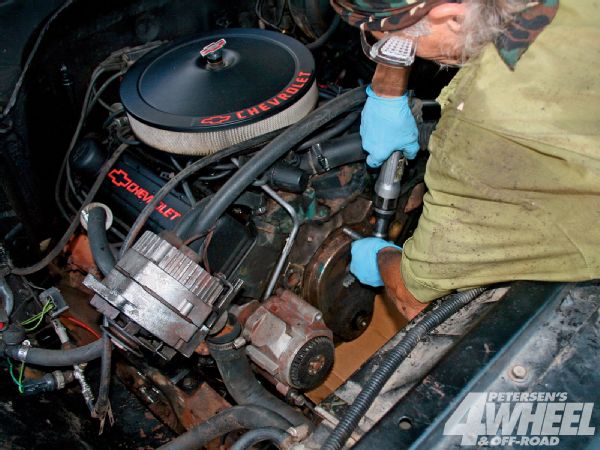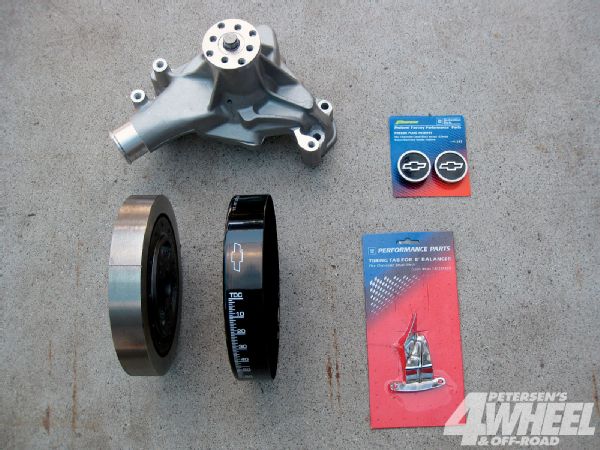
British sports-car owners expect to see oil spots on their concrete. Like fast food and cholesterol, this comes with the territory. Fortunately, American engine-sealing technology makes newer Detroit Three trucks and 4x4s fairly leak-free. For engines that do spring seeps, aftermarket gaskets and goops offer enduring fixes.
 Most of the engine accessories must be removed to assess the timing cover. This means draining the coolant, removing the fan and shroud, removing or loosening the alternator and steering pump, and pulling the water pump.
Most of the engine accessories must be removed to assess the timing cover. This means draining the coolant, removing the fan and shroud, removing or loosening the alternator and steering pump, and pulling the water pump.
Top-engine lube-outs are comparatively simple. Down-low leaks are another issue, though. Engine front and rear seals and oil pan gaskets aren't as easy to change as the average valve-cover gasket. Timing cover gaskets and seals are also more-challenging.
After living with minor leaks for years, we were finally motivated by petroleum's premium price to address timing cover leaks on a '77 Chevy 3/4-ton. We previously fixed leaky valve covers with premium Fel-Pro gaskets and Proform black crinkle valve covers (part of an engine dress-up kit that also includes a timing chain cover as well as an air cleaner). Being pragmatic/lazy, we delayed installing the timing cover and fixing the lower front-engine leaks until the coolant needed to be flushed. Here are some tips.
 Because the Proform timing cover replaces an OE one with a welded-on pointer, we also needed a bolt-on pointer. (Our emissions testers verify timing.) Prepared for the worse, we obtained a Proform aluminum water pump and an OE-replacement damper. As dessert, Proform also offers freeze-plug dress-up inserts and a patented balancer cover that improves timing visibility.
Because the Proform timing cover replaces an OE one with a welded-on pointer, we also needed a bolt-on pointer. (Our emissions testers verify timing.) Prepared for the worse, we obtained a Proform aluminum water pump and an OE-replacement damper. As dessert, Proform also offers freeze-plug dress-up inserts and a patented balancer cover that improves timing visibility.
•On some models and years, the oil pan might need to be lowered to install the timing cover and new front seal. This can involve removing the distributor cap, undoing the motor mount bolts, and raising the engine with a cherry picker to create oil pan clearance. Hope for the best, but plan for the worst: Buy a new oil pan gasket and rear main seal before diving in.
•Measure the distance between the existing harmonic balancer and the engine block for accurate reinstallation. Otherwise, the pulleys might not line up.
•Shop manuals recommend gasket sealers and dabs of RTV silicone at strategic points. Many pros prefer Permatex No. 2 Form-A-Gasket Sealant.
•Suspect accessories, such as the water pump, alternator, balancer, or steering pump, are convenient to replace in conjunction with doing the timing-cover job.
•Chevy timing pointers vary depending on vehicle and year. GM changed from bolt-on to weld-on pointers in 1986. An aftermarket timing cover might also need an aftermarket pointer.
•Inexpensive test strips assess coolant condition. All coolant should be secured from kids and pets, and contaminated antifreeze should be disposed of properly.
Highly caffeinated Chevy Gen I small-block owners can possibly complete the job in about half a day, particularly if their engines don't have smog pumps or A/C compressors cluttering up access. We spent a weekend steam-cleaning away caked-on block grime and painting, breaking, and replacing engine accessories before reinstalling them. The result is a comparatively sano engine compartment and a driveway that's finally worth pressure washing.
PhotosView Slideshow

 PhotosView Slideshow
PhotosView Slideshow


